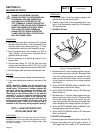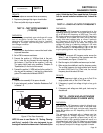
*
DANGER: USE EXTREME CAUTION
DURING THIS TEST. THE GENERATOR WILL
BE RUNNING. HIGH AND DANGEROUS
VOLTAGES WILL BE PRESENT AT THE
TEST TERMINALS. CONNECT METER TEST
CLAMPS TO THE HIGH VOLTAGE TERMINALS
WHILE THE GENERATOR IS SHUT DOWN.
STAY CLEAR OF POWER TERMINALS
DURING THE TEST. MAKE SURE METER
CLAMPS ARE SECURELY ATTACHED AND
WILL NOT SHAKE LOOSE.
PROCEDURE:
1. With the engine shut down, connect the AC voltmeter
test leads across the Wires 11 and 44 terminals of the
generator main circuit breaker (see Figure 1). These
connections will permit line-to-line voltages to be read.
2. Set the generator main circuit breaker to its OFF or
“Open” position. This test will be conducted with the
generator running at no-load.
3. Start the generator, let it stabilize and warm up for a
minute or two.
4. Take the meter reading. On 12-20 kW units the no-load
voltage should be between 249-247 VAC. On 8-10 kW
units the no-load voltage should be between 220-235 VAC.
5. Shut the engine down and remove the meter test leads.
RESULTS:
1. If Step 4 indicated proper voltages, discontinue testing.
2. If any other readings were measured, refer back to flow
chart.
NOTE: “Residual” voltage may be defined as the
voltage that is produced by rotor residual mag-
netism alone. The amount of voltage induced into
the stator AC power windings by residual volt-
age alone will be approximately 2 to 16 volts AC,
depending on the characteristics of the specific
generator. If a unit is supplying residual voltage
only, either excitation current is not reaching the
rotor or the rotor windings are open and the exci-
tation current cannot pass. On current units with
air-cooled engine, “field boost” current flow is
available to the rotor only during engine cranking.
TEST 4 – FIXED EXCITATION TEST/
ROTOR AMP DRAW TEST
DISCUSSION:
Supplying a fixed DC current to the rotor will induce a
magnetic field in the rotor. With the generator running,
this should create a proportional voltage output from
the stator windings.
PROCEDURE:
1. Disconnect Wire 4 from the voltage regulator, 3rd
terminal from the top. See Figure 2.
2. Connect a jumper wire to the disconnected Wire 4 and
to the 12 volt fused battery supply Wire 15B (located at
TB1 terminal board).
3. Set VOM to AC volts.
11
22
4
4
0
6
2
Figure 2. Voltage Regulator
4. Disconnect Wire 2 from the voltage regulator and con-
nect one meter test lead to that wire. Disconnect Wire
6 from the voltage regulator and connect the other
meter test lead to that wire. Wires 2 and 6 are located
at the bottom two terminals of the voltage regulator
(see Figure 2).
5. Set the AUTO-OFF-MANUAL switch to MANUAL. Once
the engine starts, record the AC voltage.
6. Set the AUTO-OFF-MANUAL switch to OFF. Reconnect
Wire 2 and Wire 6.
7. Disconnect Wire 11 from the voltage regulator and con-
nect one meter test lead to that wire. Disconnect Wire
22 from the voltage regulator and connect the other
meter test lead to that wire (both wires are located at the
top two terminals of the voltage regulator, see Figure 2).
8. Set the AUTO-OFF-MANUAL switch to MANUAL. Once
the engine starts, record the AC voltage.
9. Set the AUTO-OFF-MANUAL switch to OFF. Reconnect
Wire 11 and Wire 22.
10. Set VOM to DC amperage.
11. Remove jumper lead connected to Wire 4 and Wire 15B.
12. Connect one meter test lead to battery positive 12
VDC supply Wire 15B, located at TB1 terminal board.
Page 42
PART 2
AC GENERATORS
SECTION 2.4
DIAGNOSTIC TESTS


















